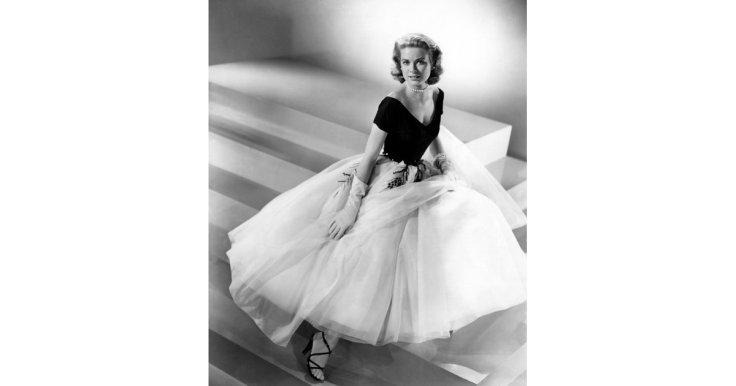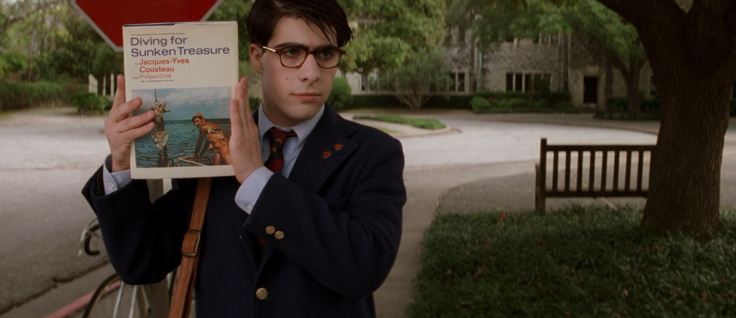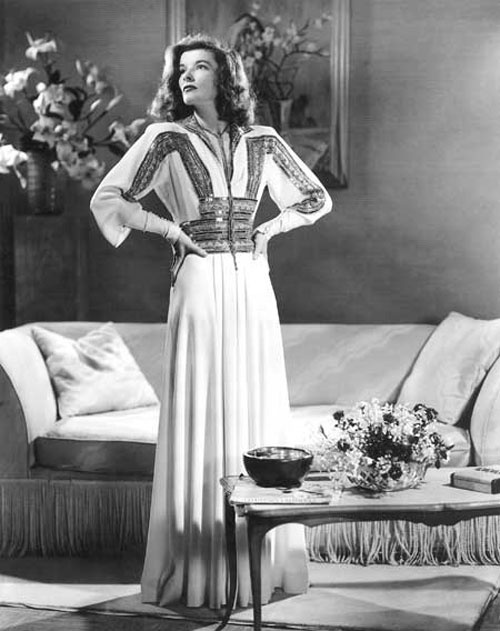Wardrobe is integral to the building of character. Those who dismiss costume as frippery or fashion miss the point spectacularly. Costume builds worlds, builds character, and works to immerse the audience in the cinematic universe where a film takes place. As such, here are my favourite character wardrobes in film.
10. Audrey Tautou as Amélie Poulain in Amélie (2001), Designers Madeline Fontaine and Emma Lebail: Amélie is caught in a dream world, a hazy, childlike invention of her own. She has never quite grown up, and is still susceptible to a childlike sense of wonder and excitement. Her costume design certainly reflects this. Her clothes are often bright, frequently patterned, and usually simple. They undeniably possess a certain Parisian chic, with clean cuts and earthy colours giving them a certain French je ne sais quoi. Amélie pairs chunky, Doc Marten-esque shoes with feminine skirts and cardigans, giving her inoffensive style a slightly punky edge, and making her skinny legs look even more childlike. Her brightly patterned cardigans lend her a whimsical quality, making her figure pop out against her environments. Indeed, much of Amélie’s wardrobe is designed to make her stand out from the extras. She is a compelling, girlish figure, and manages both to stick out and to integrate into her surroundings – without the costume design, she’d be far less unique a character.
Best Costume: Amélie’s yellow cardigan emblazoned with polka dots, which she wears in the wrenching scene where Nino arrives at Les Deux Moulins, unaware that the girl he has been searching for is right under his nose. The cardigan is childish, a little gaudy, and pops out against the earthy toned walls of the café in a wonderful way.

9. Grace Kelly as Lisa Fremont in Rear Window (1954), Designer Edith Head: Yes, this one is perhaps more about fashion than character. Grace Kelly’s wardrobe in Rear Window is undeniably high fashion. I have to admit, when Lisa made her big entrance in her dazzling black and white dress (“imported from Paris”), she looked so stunning that I gasped out loud. Besides being simply gorgeous, however, the dress does serve a purpose. It encapsulates Lisa’s character perfectly. The dress is perfectly tailored and obviously expensive, and from this, we can deduce that Lisa is wealthy, perhaps a little frivolous, and clearly a socialite. Of course, we later find out that all this is true. Lisa describes the dress as “a steal at $1100”, and is described as never wearing the same dress twice. However, Lisa clearly knows her trade. Her dress is fashionable, relatively minimalistic, and befitting of a socialite/model. Lisa’s outfits, on occasion, symbolise her state of mind/the events taking place. For example, as Lisa begins to believe Jeff’s tale of murder, she is wearing a simple black dress, black representing the darkness of the moment. And as the film draws to a close, Lisa is shown wearing trousers and a simple shirt – symbolising her acceptance into Jeff’s lifestyle. Lisa’s wardrobe is undeniably fashionable, but manages to represent her character and her status at the same time.
Best Costume: It’s got to be the Paris dress. Extravagant, impractical and straightforwardly beautiful, it tells us everything we need to know about Lisa before she even starts to speak. This woman is glamorous, perhaps too glamorous to be shackled up to Stewart’s indifferent reporter. She’s chic, modern and beautiful, and she knows it. This is Edith Head at her best.

8. Michael J. Fox as Marty McFly in Back to the Future (1985), Designer Deborah Lynn Scott: “Hey kid, what did you do, jump ship?” a coffee bar manager inquires of Michael J. Fox’s Marty in Robert Zemeckis’ 1985 classic Back to the Future. Little did he know that the very “life-preserver” he was ridiculing would become one of the most iconic costumes in film history. It is not an overstatement to say that Marty’s iconic, multi-layered outfit would come to define early 80s teen fashion. And speaking of multi-layered, Marty certainly must have been sweltering. Off the top of my head, I can recall a red t-shirt, a checked shirt and braces, a patchwork denim jacket and the orange/red body warmer all being worn simultaneously. To top it all off, you have those stonewashed jeans. They’re brilliantly hideous – the 80s defined in denim. Oh – and the chunky Nike trainers. The perfect outfit for a modish 80s teen. I don’t doubt that many a young boy modelled themselves on Marty’s style. There isn’t anything symbolic in the outfit – it doesn’t represent anything. It’s just the perfect distillation of the fashion of the era. It’s iconic, and sometimes a character wardrobe doesn’t need to be anything else.
Best Costume: Red t-shirt, checked shirt, braces, denim jacket, stonewashed jeans, orange body warmer. It’s truly iconic. When all the items of the outfit are worn together, a defining moment in film fashion is born. The colours contras brilliantly, and Marty looks so gloriously 80s – all floppy hair, stonewashed denim and patchwork clothes. Iconic. What more is there to say?

7. Gwyneth Paltrow as Margot Tenenbaum in The Royal Tenenbaums (2001), Designer Karen Patch: Margot Tenenbaum can perhaps be credited – for better or worse – as the inspiration behind hipster style. With her Fendi fur coat, Lacoste tennis dress and eye makeup that screams “don’t talk to me”, Margot is the perfect fashion icon – achingly cool, stylishly aloof and fashionably damaged. Margot’s style is frozen in time, just like her siblings. The Tenenbaum siblings are all trapped in moments of torment. Richie continues to wear his old tennis head-bands, still dressed like a tennis star despite his previous on-court breakdown. Chas wears the same bright red Adidas tracksuits as his sons – still caught in the tragedy of his wife’s death and dressing his sons so that he can see them at all times. Margot, just like her siblings, is trapped in her childhood, a childhood where she felt she didn’t fit in and was not accepted. The many flashbacks to a young Margo show her in exactly the same outfit: the tennis dress; the fur coat; the eye makeup. The fur coat gives her a sort or regality – a quiet dignity which she carries with her despite her emotional turmoil. The tennis dress implies sportiness, a casually preppy style that is at once modern and retro. It also links her to her brother Richie, a former tennis star. The eye makeup mimics the kind of makeup one wears as an angsty teenager, blacking out the eyes almost completely. Margot is a graceful woman, a petulant teenager and a wounded child all at once, and her costume encapsulates these contradictions perfectly.
Best Costume: Her iconic ensemble of fur coat, blue tennis dress and black eyeliner – the outfit that came to define the early 2000s hipster. It’s the perfect example of costume serving character perfectly, and I rank it highly for this reason.

6. Jason Schwartzman as Max Fischer in Rushmore (1998), Designer Karen Patch: It’s the little details about Max Fischer’s costume that prove integral. It’s entirely possible, for example, not to notice that Max is the only student wearing a blazer until a second, or even third viewing. Most importantly, the uniform ties Max to the prestigious Rushmore Academy – and perhaps gives a false first impression of Max’s wealth and status. Max is clearly wildly proud of his place at Rushmore, and as such, he decorates his uniform with every possible piece of adornment possible: pins on his lapels; a crimson beret; the navy blazer. It illustrates great pride, but also hints at social insecurity. Max spends the film struggling with his lowly origins, and trying valiantly to fit in. His costume illustrates this perfectly – he flaunts the school’s upmarket reputation and yet sticks out like a sore thumb all the same. Max doesn’t wear his uniform, it wears him. He uses his uniform to manipulate others perceptions of him – encouraging them to think of him as wealthy and affluent when the reality is quite different. Everything Max wears is a little too mature, as if he is trying to give himself a self-confidence boost. One should also keep in mind that Max is besotted with an older woman – Miss Cross, a beautiful teacher at Rushmore. It isn’t too much of a stretch to imagine Max selecting his outfits with aim of impressing Miss Cross with a suave velvet jacket. It’s only when Max is pushed away from Rushmore that he begins to dress his age – wearing a chunky skiing coat and Charlie Brown-esque fur hat. Max’s outfits reflect his insecurities, and seem to become more and more significant with repeated viewings. Patch and Anderson make the perfect team, it seems.
Best Costume: The Rushmore uniform is the clear winner. It encapsulates Max’s intense desire to fit in whilst also showing how spectacularly he has failed in this attempt. There’s something rather endearing about it, as Max strives to emit a vibe of success and affluence that we as the audience know he cannot ever possess.

5. Katharine Hepburn as Tracy Lord in The Philadelphia Story (1940), Designer Adrian Adolph Greenberg: Katharine Hepburn adored Adrian. Indeed, she is quoted as saying: “Adrian was my favourite designer. He and I had the same sense of ‘smell’ about what clothes should do and what they should say.” Adrian helped to define the style of many a 1930s star, with notable alumni including Greta Garbo, Marlene Dietrich and Jean Harlow. When Katharine Hepburn requested that he provide her costumes for The Philadelphia Story, she was delighted to see that he had exactly the same ideas for what Tracy should wear as she did. Notably, Adrian was a big fan of trousers for women, and managed to slip three suits into Tracy Lord’s wardrobe, despite the objections of studio head Louis B. Mayer. All three of these suits are powerful, characterful things – bursting with personality and conveying a great inner strength. But with Adrian, it all comes back to the gowns. Sometimes it seems that every noteworthy film of the 1930s begins with the credit “Gowns by Adrian.” Queen Christina (1933), The Wizard of Oz (1939), Ninotchka (1939) – all with gowns by Adrian. He worked his magic once again with The Philadelphia Story, creating a glorious Greek-inspired gown that screams goddess. If Hepburn entered the screen holding a sword and shield whilst wearing the gown, it wouldn’t look all that out-of-place. She looks absolutely fearsome, powerful and gorgeous. The intricate, art-deco inspired beading on the front of the gown almost resembles armour, and Hepburn specifically requested that the gown be cut in the boxy style usually linked to Joan Crawford, though with the edges softened. This made for a dress implying both power and femininity, and shows Hepburn’s skill at controlling her image. This is Hepburn making herself palatable for the general public whilst refusing to compromise all that makes her an individual. Overall, I chose this character wardrobe more for how it expertly plays upon Hepburn’s public image at the time than for any character building it does. Adrian and Hepburn are the perfect match, and Tracy Lord’s gowns transcend time for a reason.
Best Costume: The gorgeous Grecian gown. Powerful, feminine and characterful, it’s the perfect encapsulation of both Tracy Lord the character and Katharine Hepburn the image. It’s perfectly designed, playing up Hepburn’s strong shoulders and miniscule waist. It almost resembles her costume as Antiope from The Warrior’s Husband. Evidently, Hepburn and goddesses are good matches.



Leave a comment